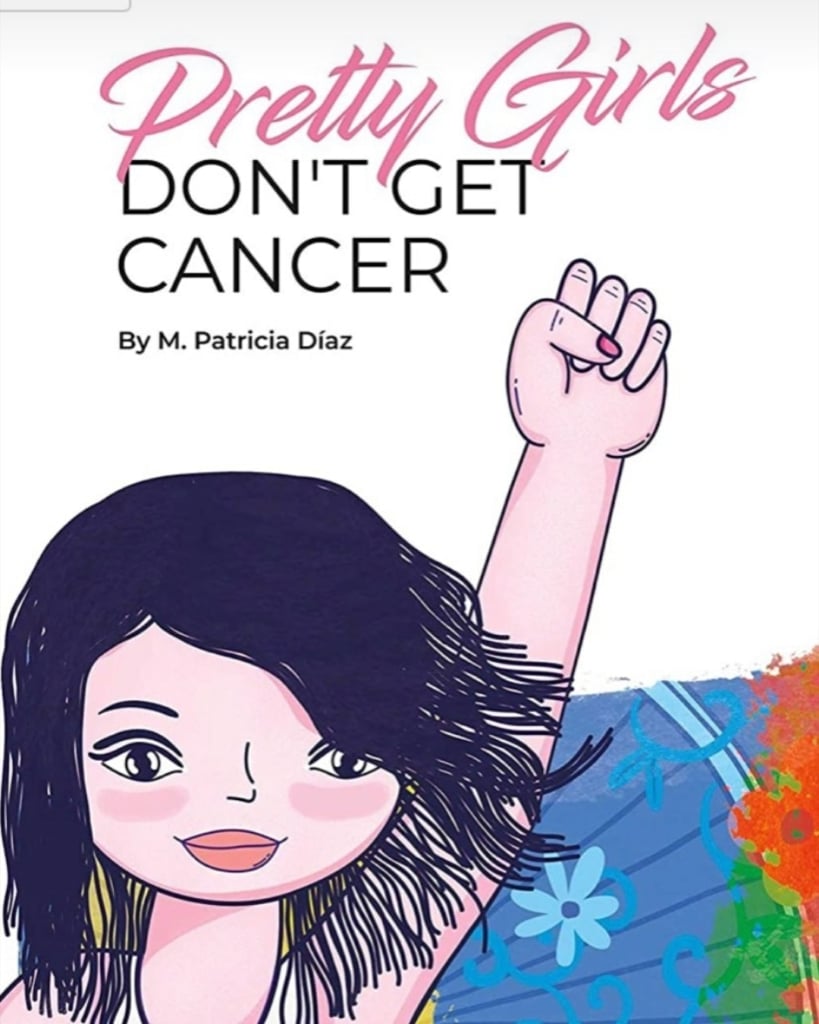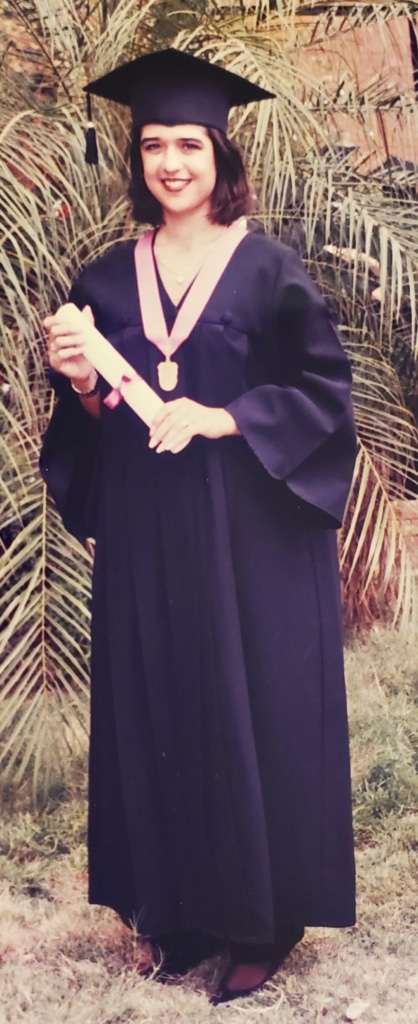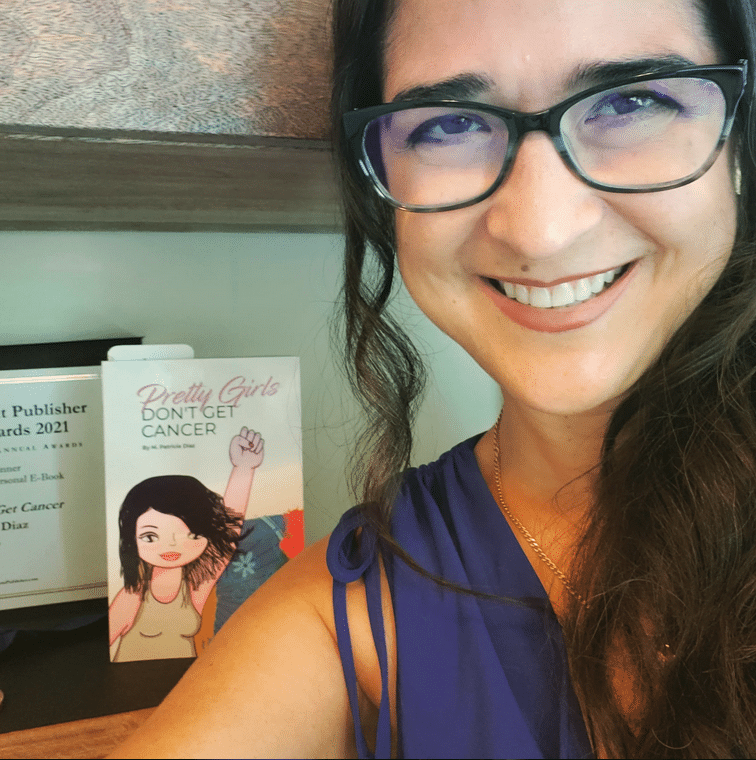It was 1989 and I was living in Maracaibo, Venezuela, when I experienced my worst nightmare.
I was sixteen years old and full of dreams. I had great friends, an active social life, and a dreamy boyfriend. I was no longer sharing a bedroom with my sister, as she had recently left home to go to college in Caracas. So, I even had a room all to myself! Life was carefree in some ways. My friends and I would often go on bike rides through the narrow streets of Maracaibo. My pink shorts and white T-shirt were the perfect outfit to withstand the 100-degree tropical heat. I felt invincible—as if nothing would ever go wrong.
But my reality quickly turned around. A deadly stage 4 cancer manifested itself in my body, catching my family and me completely by surprise. It was Christmas time when the symptoms became more noticeable. My energy wasn’t the same. In truth, I had not been well for a while, but that December, headaches became more frequent, difficulty breathing more intense, and I had nose bleeds I could not explain and a persistent cough that oppressed my lungs and made even speaking a difficult task. My tan face was then an anemic yellow and my brown hair looked dull and lifeless.
I looked at my lungs on the X-ray—one was white and the other black.
Mother noticed the coughing over the phone one day. Worried about me, she demanded I go with her to visit her doctor on Monday morning. Mom and I had lived apart since my parents’ divorce when I was five, and we had learned to have a far-away pleasant relationship. I wanted her closer but that was something I could not control.
When mom took me to her doctor, I was barely able to breathe. I looked at my lungs on the X-ray—one was white and the other black. Shortly after, I was surrounded by doctors and nurses, family and relatives. I had no idea what was happening.
After tests and medical deliberation, I was misdiagnosed—three times. More accurately, four if we count that one doctor who dismissed my earlier symptoms telling me not to worry because “Pretty girls don’t get cancer.” That phrase became the title of my recent memoir as a symbol of resiliency in the face of ignorance.

Malpractice led the doctors in my family to intervene. Hence, my parents took me to another hospital to undergo treatments with my uncle’s mentee who was an exceptional and controversial internal medicine doctor. Chemo started that same night; this doc seemed angry and on a roll. He had an infamously direct communication style and warned my parents to stick around—in case I died that night. Although I didn’t quite die, that first chemo felt like the inside of my body was slowly melting. I wanted to be freed from the shackles of that disease and was in so much pain! To date, that was by far the worst night of my life. Thankfully, medicine has advanced significantly since the eighties and I understand some new treatments are less aggressive, and preventive screening can allow for early detection and treatment.
To everyone’s surprise, 90% of malignancies vanished with only one treatment.
My recovery was miraculous. That’s how it felt to me. To everyone’s surprise, 90% of malignancies vanished with only one treatment. A few days after that first night, the doctor found me sitting upright in the hospital bed sipping chamomile tea. With a blurry mind I was unable to keep track of days, so that became the “energy came back to my body” day. I saw a glimpse of a smile on the doc’s serious face, especially because the test results showed almost imperceptible traces of that cancer.
After eight treatments and a complete remission, the journey was far from over. The same corrosive treatment that saved me left devastation in my body that no one in my family knew how to fix. I was left with a thin, weak, yet living body and the unanswered question: how do I restore wellness to my body after cancer treatments? In addition to being thin and weak, my mind was slower, I would faint without warning, my skin and hair were dry, I had marks on my skin, and I became more introverted—among many other changes and symptoms I experienced.
It was the early nineties, I was just out of high school, and I was thrilled to still be alive. Back then, integrative therapies didn’t have a place in healthcare communities. However, my sister, a science pioneer in the family, introduced us (and mostly me) to natural healing options that I probably wouldn’t have considered without her influence. She introduced me to yoga, three-part breathing techniques, meditation, plant-based or plant-rich diets, and forgiveness psychotherapy to learn to live in peace. I wish we had had organizations like CancerChoices to help us through cancer and help me recover the broken pieces. Instead, we created our own path without a compass, allowing my sister’s love and intuition to guide us through that next phase. I had no idea if anything would work, but life was worth trying anything for, and I was willing to live and give everything a chance.

If I were to point to one personal trait that got me (and us) through the crisis, it is that I opened my heart to exploration. If someone back then had suggested that handstands cured cancer, I would have walked with my hands. I’m not joking. No idea was too wild, too crazy, or too “woo woo” not to merit the effort of trial and error, even when science had yet to prove the effectiveness. I just said yes, sometimes for the sake of fun. I was hungry for knowledge and possibilities. So much so, that information flooded us: there was much more than I was able to digest as a teen. But the years that followed remission turned into years of healing, discovery, roller coaster rides, and many “aha” moments of mind-body-spirit recovery. The only conventional care I received after cancer treatment was checkups every 6 months in the first years, then yearly checkups including CAT scans, blood tests, X-rays, and more.
We focused on using the practices introduced by my sister to empower my immune system to do its natural work instead of focusing too much attention on statistical odds. I chose to believe I could do it and had people around me to cheer me through every step. My challenge was the well-intentioned people who spoke through their own experiences and fears. They seemed convinced that I would not recover and that complete awareness of reality would better prepare me for the inevitable forthcoming death. And although there is value to grounding in reality, most of them didn’t take into account their own filters and the negativity in their minds. Hence, my family decided to restrict visits, and that choice was not only for my sake. We had to focus on the possibilities and eliminate the drama-feeding souls from the picture. Surrounding ourselves with affirmative influencers made a huge difference in my recovery.
If I were to point to one personal trait that got me (and us) through the crisis, it is that I opened my heart to exploration.
By the time I was twenty-six, I was stable enough to go to the US to pursue a master’s degree. I continued my yoga practice in America, and added tai chi, acupuncture, massage, herbs, and additional exercise. Work-life balance became a challenge in my thirties as I focused on my career, but as time allowed, I continued with these therapies and the practices my sister had introduced me to.
During my healing journey I also started to rewire my brain to find joy and crave wellness. I’ve not mastered this skill, as life after remission hasn’t been full of laughter. Instead, it has been a true roller coaster full of unknowns and mysteries. But all things considered, I did find, and now own, the key to my happiness and when things don’t go as hoped, I have the power to open my own door and walk towards my happy place. I thank my psychotherapist (RIP) for teaching me the blessing of forgiveness and personal accountability.
I was in my forties when I came across functional medicine. After hitting a dietary wall due to a slower metabolism, I pursued a culinary certification at the Natural Gourmet Institute. I was on another quest to understand aging and under AnnMarie Colbin’s health-supportive program, we studied the work of Dr. Mark Hyman. His functional approach to wellness made perfect sense to me and I adopted his recommendations for healthy living. I wanted a better blend of Eastern and Western philosophies in my preventive care. Some of the practices I adopted most recently under the care of my functional MD include intermittent fasting, elimination diets, detoxification, Pegan® diet, restful sleep, and regular exercise. Today I feel great and fully recommend exploring these options, especially under medical care. I’ve found it helpful to reassess preventive strategies, adjusting and adapting through different stages of life.
I still fully trust my instincts and especially listen with attention to the messages my body sends to me.
Today I have my personal Wellness Board of Directors, led by me, with the strongest and most innovative advisors I could possibly find: my primary care physician, functional medicine doctor, dentist, OB-GYN, vision and other specialists, family members, physician friends, and others. I consult my Board regularly on any wellness matter so that together we can make informed decisions. I still fully trust my instincts and especially listen with attention to the messages my body sends to me. I am the one that gets to live in my own body, and although I have the final say, their advice and care have been life-changing!
Natural healing options are powerful. Based on my personal experience, I think they should have a stronger presence in our healthcare system, from disease prevention to symptom management and from benefit coverage to other social support options, such as from Medicare and Medicaid. Alternative and complementary healing methods are empowering as they help patients feel more in control of their self-care and wellness.

The techniques I’ve experimented with are not the only ones out there, and the outcome is not always guaranteed. Many doctors and practitioners have dedicated their careers to researching options that help patients recover and maintain their health. My greatest advice is to learn to listen to your own body and to explore healing options that work best for your body type. Becoming an expert in self-observation will not only give you tools to confront the difficulty you are facing today, but perhaps also for other life challenges in the future. And most importantly, you’ll likely have more resources to help you thrive in a new transformed life. All the best in your journey!
M. Patricia Díaz is the author of “Pretty Girls Don’t Get Cancer” and a yoga/meditation instructor.
